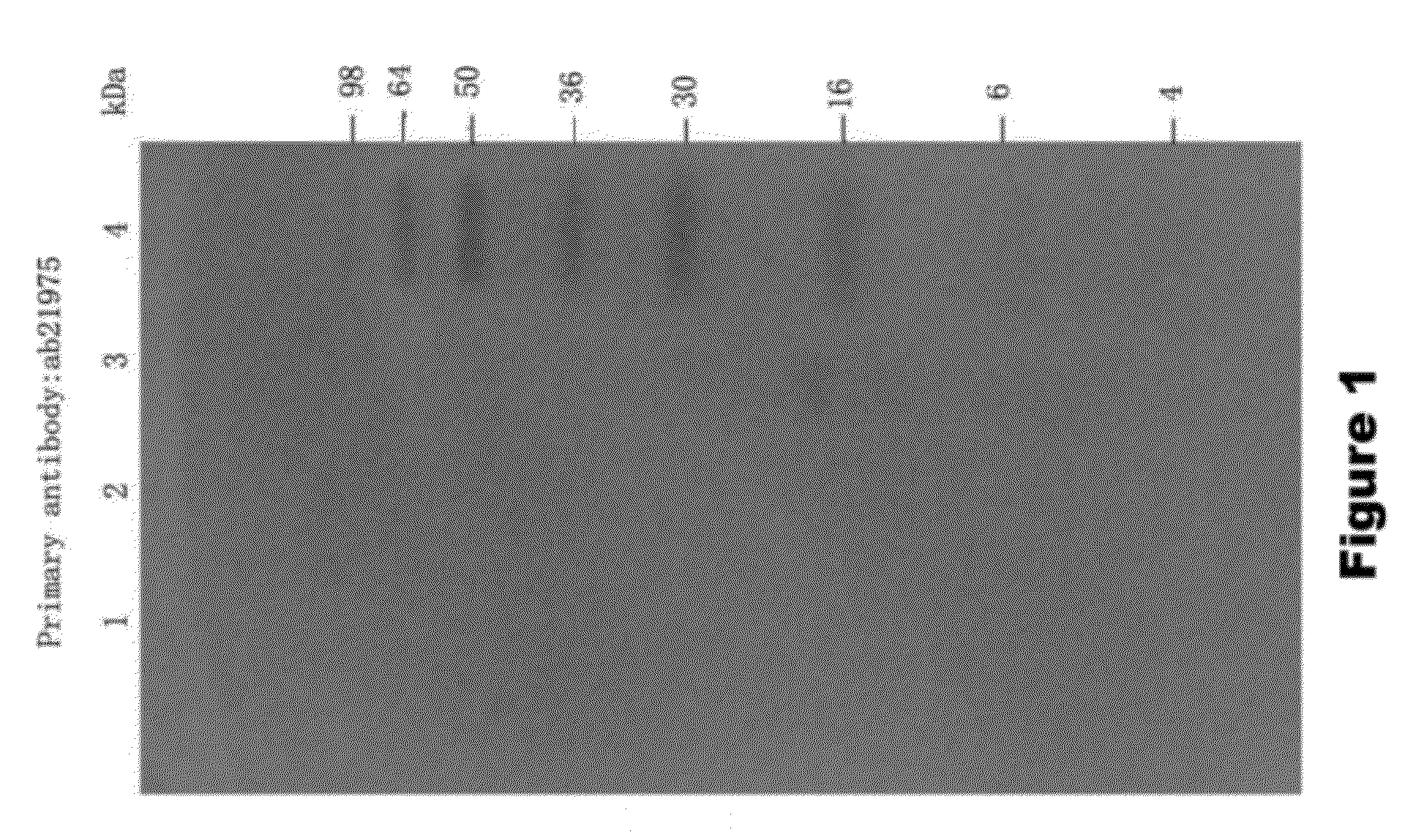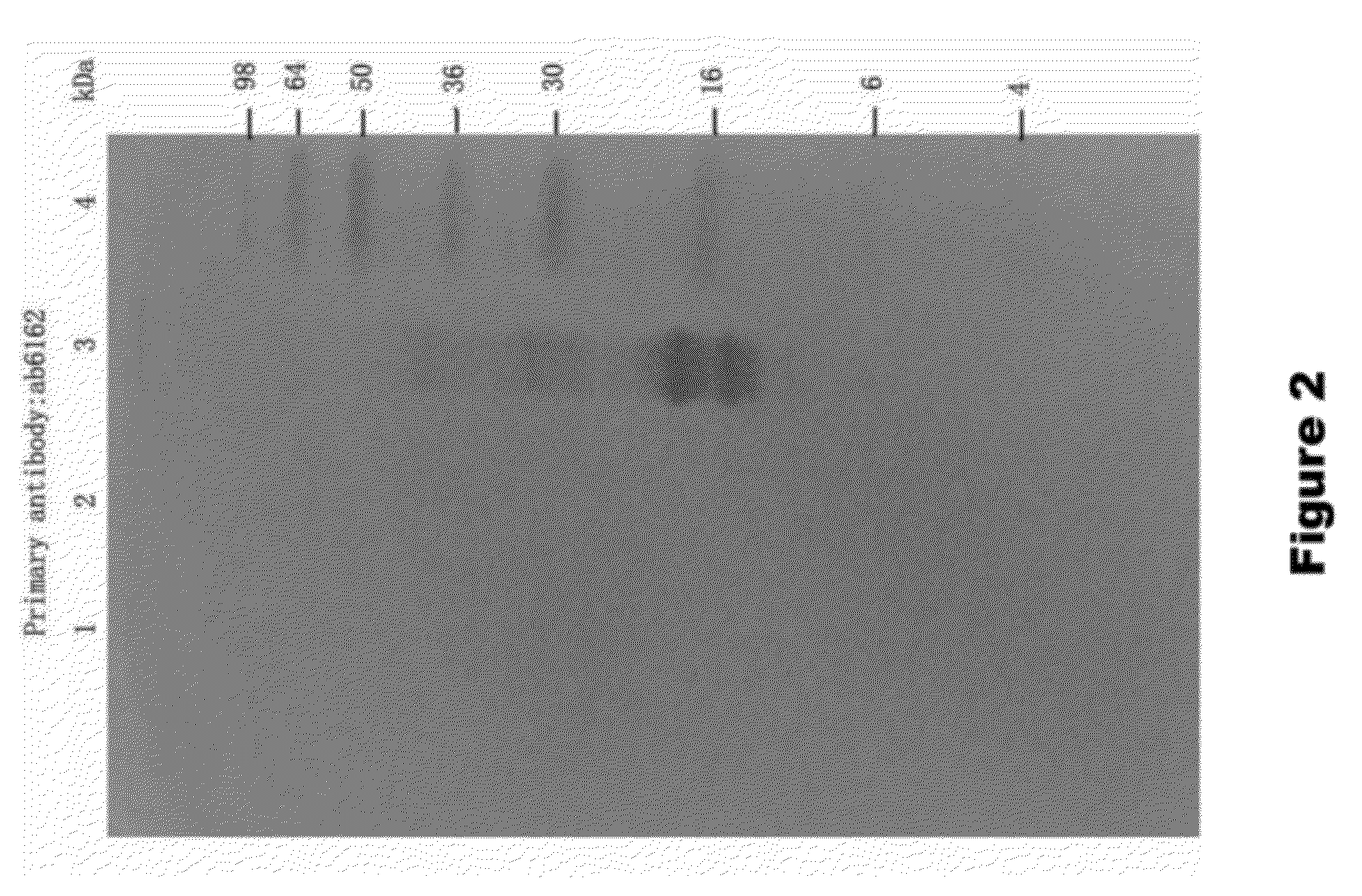Tissue kallikrein for the treatment of parkinson's disease
a tissue kallikrein and parkinson's disease technology, applied in the field of tissue kallikrein for the treatment of parkinson's disease, can solve the problems of pd and dlb, and present a huge financial burden on the health care system, and achieve the effect of improving glucose uptak
- Summary
- Abstract
- Description
- Claims
- Application Information
AI Technical Summary
Benefits of technology
Problems solved by technology
Method used
Image
Examples
example 1
In vitro Cleavage of α-Synuclein by KLK1
Cleavage Assay
[0136]To assay the ability of KLK1 to cleave full length α-synuclein (1-140 AA), recombinant α-synuclein (rPeptide) was treated with porcine pancreas derived KLK1 in PBS solution. The following samples were incubated for 24 hours at 37° C.: 100 nM KLK1+2.5 μM α-synuclein, 100 nM KLK1 alone, and 2.5 μM α-synuclein alone. Each sample of KLK1 contained 50 nM of soybean trypsin inhibitor (Sigma, St. Louis). At the completion of the incubation period, the samples were run on a 15% SDS-PAGE gel which was then assayed by Western Blot on a PVDF membrane. The membrane was incubated in primary antibody (ab6162 or ab21975) diluted 1:5000 in blocking solution, followed by incubation with and alkaline phosphatase-conjugated secondary antibody. The membrane was then developed in a NBT-BCIP solution.
[0137]To assay the ability of KLK1 to cleave α-synuclein 1-95 (1-95 AA), recombinant α-synuclein 1-95 (GenWay Biotech) was treated with porcine pan...
example 2
Inhibition of GSK-3β by KLK1 Leads to Decreased α-Synuclein Expression and Cell Death from MPTP Treatment
[0140]The apoptosis of neurons leads to the neurodegeneration seen in Parkinson's disease. MPTP (N-methyl-4-phenyl-1,2,3,6-tetrahydropyridine) is a neurotoxin which imparts its toxic affects through the activation of the kinase GSK-36 which leads to increased expression of α-synuclein protein.
Treatment of Neuronal Cells with MPTP for 48 Hours
[0141]Primary mesencephalic neurons isolated from 16-18 day old rat embryos are plated onto 6 well dishes and grown in each well using Neurobasal medium (Invitrogen) supplemented with B27 (2% v / v, Invitrogen), penicillin / streptomycin mixture (10 U mL') and 25 μm β-mercaptoethanol at 37° C. and 5% CO2. 50 μM of MPP+ iodide (Sigma, St. Louis, Mo.) is added to each well and allowed to incubate for 48 hours. In addition, KLK1 (0.01 to 100 Units) is added to the MPP+ treated wells 24 hours after the addition of the neurotoxin. A positive control i...
example 3
KLK1 Enhances Cell Viability after Treatment with α-Syn
Aggregate Preparation:
[0146]Various forms of α-Syn (500 μM) (e.g. wild-type, minus C-terminal, A30P, A53T forms) are allowed to aggregate into fibrils by incubation in sterile water solution at 37° C. for three days, while non-aggregated forms are prepared immediately before application to the cultures.
Cell Treatment:
[0147]At embryonic day 14, brain tissue is removed from fetal rats and the cells are plated (3×105 cells per dish) in 96-well dishes (Corning, Corning, N.Y.) precoated with poly-d-lysine (50 mg / ml; Sigma, St. Louis, Mo.). The mesencephalic neurons are grown in minimum essential medium (Gibco Laboratories, Grand Island, N.Y.) supplemented with 15% fetal calf serum (Gibco) and glutamine (2 mM). Cultures are kept at 37° C. in a humidified 5% CO2.
[0148]The cells are treated with aggregated and non-aggregated α-Syn (10, 25, 50, or 100 μM) on every second day for six days with or without KLK1 (0.01 to 100 Units) beginning...
PUM
| Property | Measurement | Unit |
|---|---|---|
| Fraction | aaaaa | aaaaa |
Abstract
Description
Claims
Application Information
 Login to View More
Login to View More - R&D
- Intellectual Property
- Life Sciences
- Materials
- Tech Scout
- Unparalleled Data Quality
- Higher Quality Content
- 60% Fewer Hallucinations
Browse by: Latest US Patents, China's latest patents, Technical Efficacy Thesaurus, Application Domain, Technology Topic, Popular Technical Reports.
© 2025 PatSnap. All rights reserved.Legal|Privacy policy|Modern Slavery Act Transparency Statement|Sitemap|About US| Contact US: help@patsnap.com



